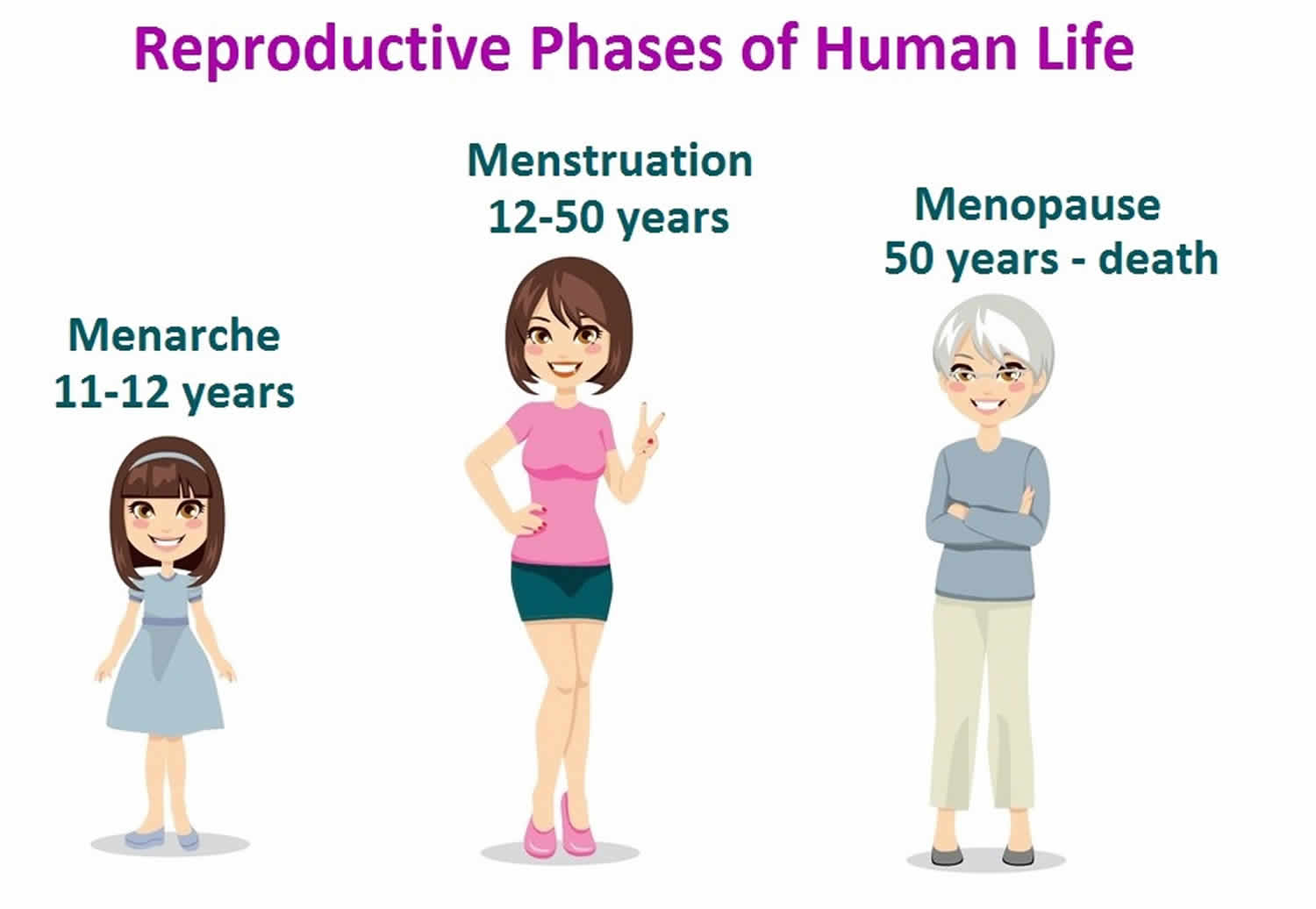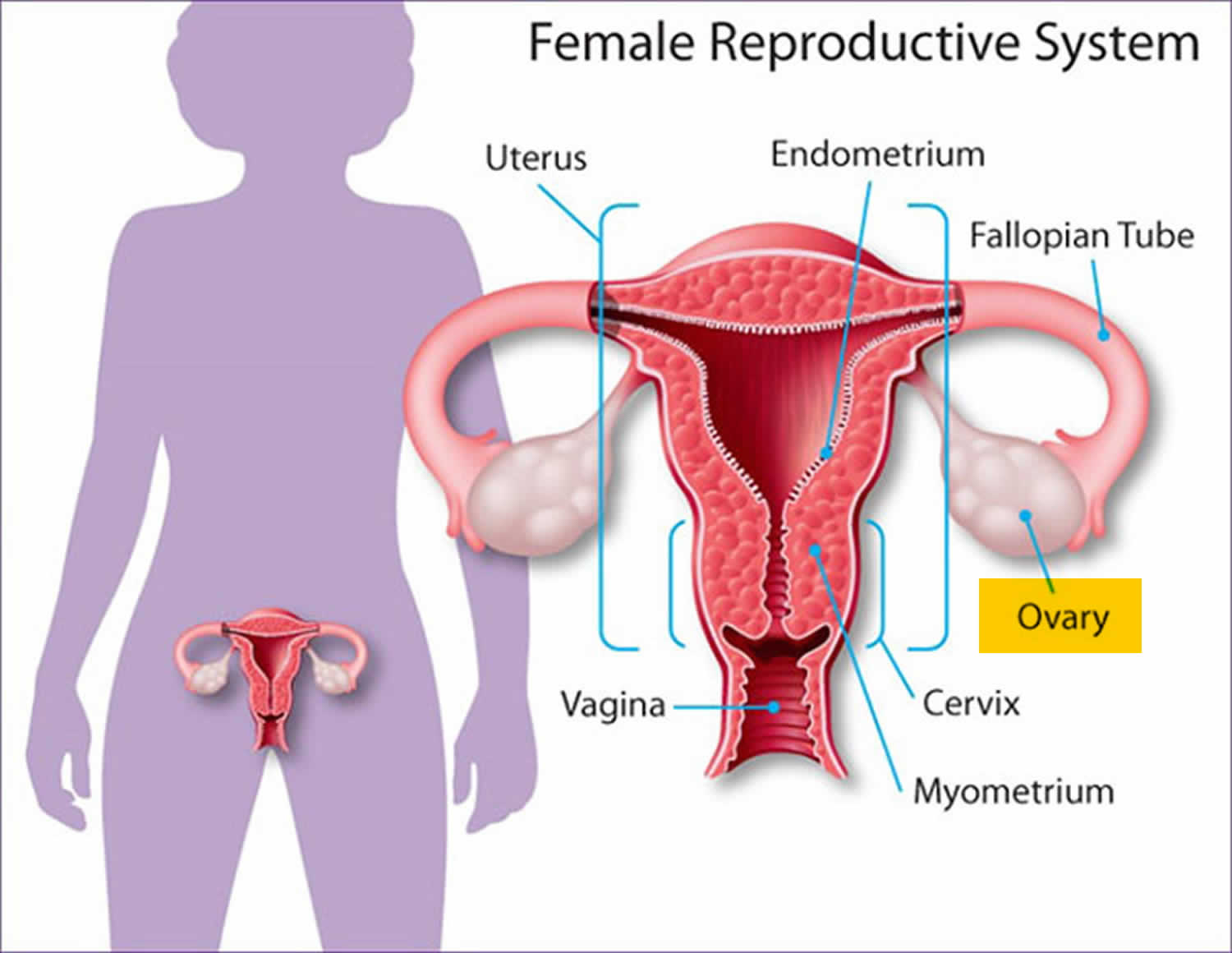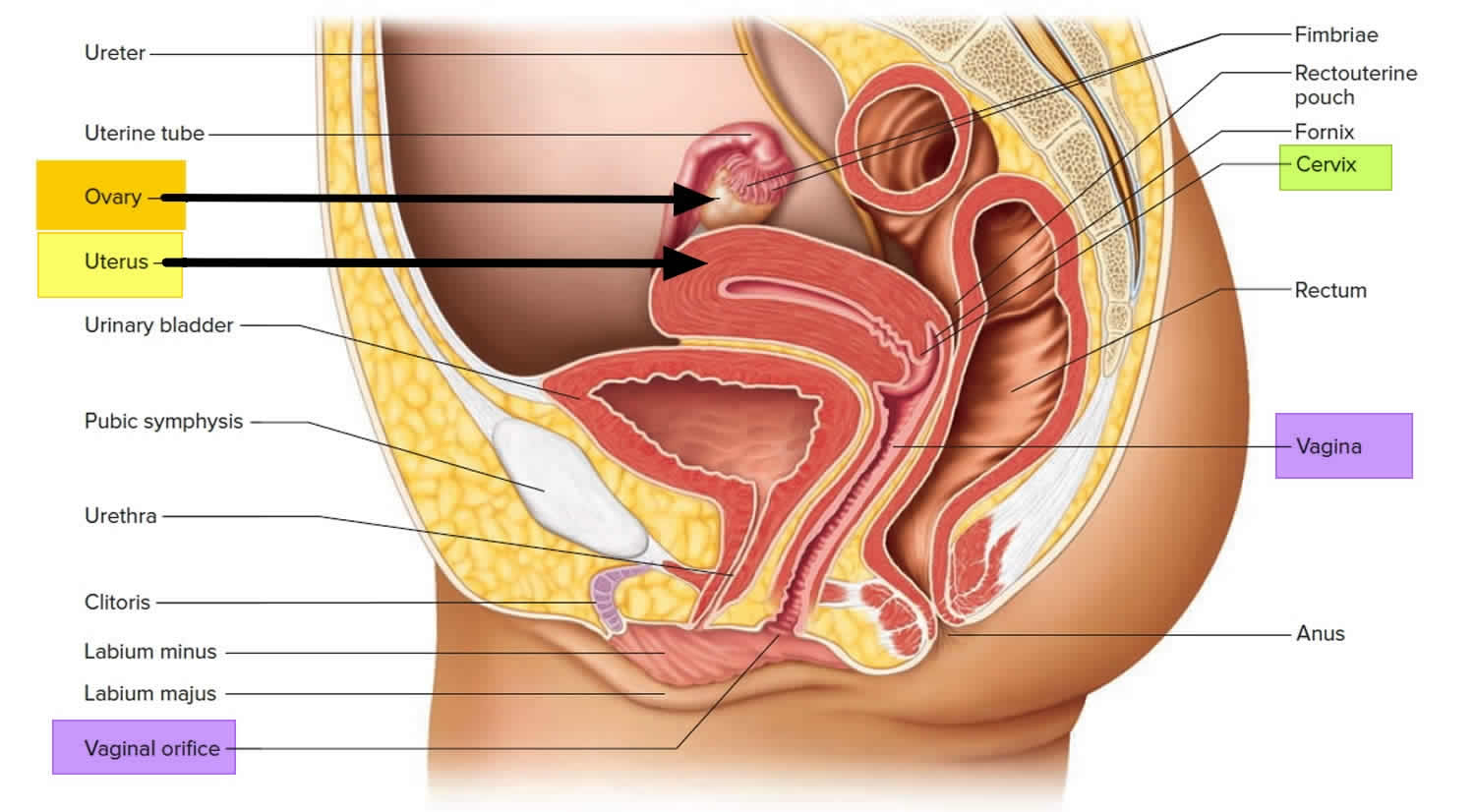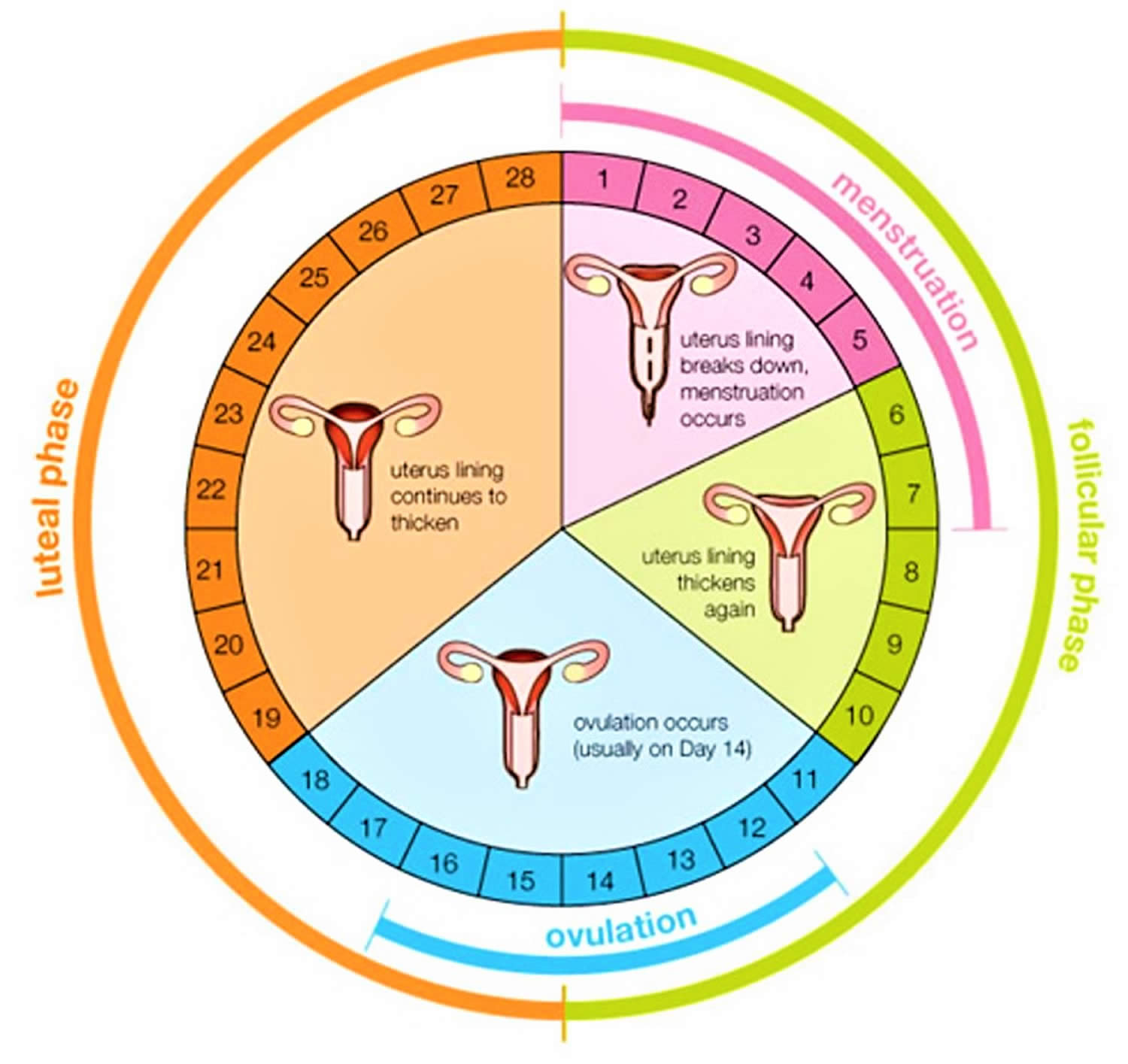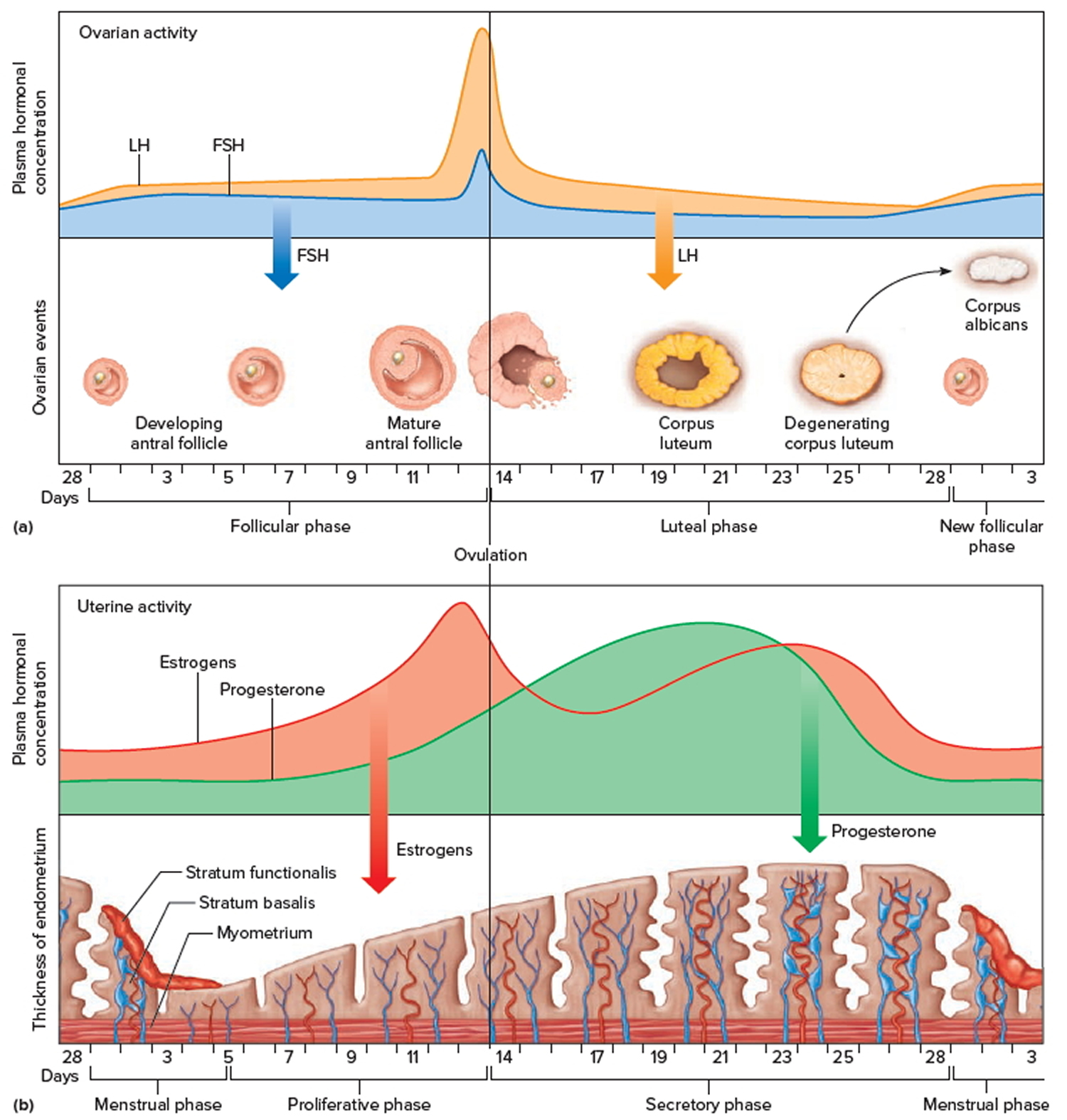Contents
- What is menarche
- The Female Reproductive System
- Menarche symptoms
- How often does a girl get her period?
- How long does a normal period last and how much blood is normal?
- What is a normal amount of bleeding during my period?
- When is menstrual bleeding abnormal?
- What are Pads, Tampons, and Liners?
- How often should I change my pad, tampon, menstrual cup, sponge, or period panties?
- What is toxic shock syndrome?
- How long is a typical menstrual cycle?
- How does my menstrual cycle change as I get older?
- How long does a woman usually have periods?
- Why should I keep track of my menstrual cycle?
- How can I keep track of my menstrual cycle?
- What is ovulation?
- How do I know if I’m ovulating?
- What happens if a pregnancy occurs?
- What are period pain or cramps?
- What are PMS and pimples?
What is menarche
A girl’s first period (menstruation) is called menarche and the average age of menarche usually starts between age 11 and 14. The average age for a girl in the United States to get her first period is 12 1. This does not mean that all girls start at the same age. A girl may start her period anytime between 8 and 15. The first period normally starts about two years after breasts first start to develop and pubic hair begins to grow. The age at which a girl’s mother started her period can help predict when a girl may start her period.
A girl should see her doctor if:
- She starts her period before age 8.
- She has not had her first period by age 15.
- She has not had her first period within three years of breast growth.
The most common reasons for girls starting their periods later than usual are:
- genetic predisposition – in some families, girls start their periods late
- doing way too much exercise
- being underweight
- stress
- some medicines
- severe long-term illness
- hormonal problems.
Menarche, the onset of menstruation, is a key developmental marker of a girl’s healthy transition from childhood into young adulthood and an important clinical indicator of girls’ physical, nutritional, and reproductive health 2. Menarche marks the beginning of a girl’s reproductive life, and has important implications for adolescent sexual and reproductive health outcomes 2. Menstruation can be confusing, just like a lot of the other changes that come with puberty. Some girls can’t wait to start their periods. Others may feel afraid or anxious.
The average menstruation time in normally menstruating women is 3 to 5 days 3 but a normal menstrual period can lasts up to 8 days 4.
The Female Reproductive System
Baby girls are born with ovaries, fallopian tubes, and a uterus. The two ovaries are oval-shaped and sit on either side of the uterus (womb) in the lowest part of the abdomen called the pelvis. They contain thousands of eggs, or ova. The two fallopian tubes (also called uterine tubes) are long and thin. Each fallopian tube stretches from an ovary to the uterus, a pear-shaped organ that sits in the middle of the pelvis. The muscles in a female’s uterus are powerful and are able to expand to allow the uterus to accommodate a growing fetus and then help push the baby out during labor.
When a girl starts puberty, the pituitary gland releases hormones that stimulate the ovaries to produce other hormones called estrogen and progesterone. These hormones have many effects on a girl’s body, including physical maturation, growth, and emotions.
About once a month, a tiny egg leaves one of the ovaries — a process called ovulation — and travels down one of the fallopian tubes toward the uterus. In the days before ovulation, the hormone estrogen stimulates the uterus to build up its lining with extra blood and tissue, making the walls of the uterus thick and cushioned. This happens to prepare the uterus for pregnancy: If the egg is fertilized by a sperm cell, it travels to the uterus and attaches to the cushiony wall of the uterus, where it slowly develops into a baby.
If the egg isn’t fertilized, though — which is the case during most of a woman’s monthly cycles — it doesn’t attach to the wall of the uterus. When this happens, the uterus sheds the extra tissue lining. The blood, tissue, and unfertilized egg leave the uterus, going through the vagina on the way out of the body. This is a menstrual period.
This cycle happens almost every month for several more decades (except, of course, when a female is pregnant) until a woman reaches menopause and no longer releases eggs from her ovaries.
Figure 1. Female reproductive organs
Menarche symptoms
The primary sign of menstruation is bleeding from the vagina.
Besides bleeding from the vagina, you may have:
- Abdominal or pelvic cramping pain
- Lower back pain
- Bloating and sore breasts
- Food cravings
- Mood swings and irritability
- Headache
- Fatigue
Premenstrual syndrome, or PMS, is a group of symptoms that start before the period. It can include emotional and physical symptoms.
Consult your health care provider if you have big changes in your cycle. They may be signs of other problems that should be treated.
How often does a girl get her period?
Just as some girls begin puberty earlier or later than others, the same applies to periods. Some girls may start menstruating as early as age 10, but others may not get their first period until they are 15 years old.
The amount of time between a girl’s periods is called her menstrual cycle (the cycle is counted from the start of one period to the start of the next). Some girls will find that their menstrual cycle lasts 28 days, whereas others might have a 24-day cycle, a 30-day cycle, or even longer. Following menarche, menstrual cycles last 21–45 days. After a couple of years, cycles shorten to an adult length of 21–34 days.
Irregular periods are common in girls who are just beginning to menstruate. It may take the body a while to sort out all the changes going on, so a girl may have a 28-day cycle for 2 months, then miss a month, for example. Usually, after a year or two, the menstrual cycle will become more regular. Some women continue to have irregular periods into adulthood, though.
As a girl gets older and her periods settle down — or she gets more used to her own unique cycle — she will probably find that she can predict when her period will come. In the meantime, it’s a good idea to keep track of your menstrual cycle with a calendar.
Figure 2. Menstrual cycle
Figure 3. Ovarian activity during the Menstrual cycle
How long does a normal period last and how much blood is normal?
The amount of time that a girl has her period also can vary. Some girls have periods that last just 2 or 3 days. Other girls may have periods that last 7 days. The menstrual flow — meaning how much blood comes out of the vagina — can vary from girl to girl, too.
Some girls may worry that they’re losing too much blood. It can be a shock to see all that blood, but it’s unlikely that a girl will lose too much, unless she has a medical condition like von Willebrand disease. Though it may look like a lot, the average amount of blood is only about 2 tablespoons (30 milliliters) for an entire period. Most girls change pads 3 to 6 times a day. They’ll probably change pads more often when their period is heaviest, usually at the start of the period.
You may be worried about whether your period is normal in other ways. This is normal when a girl first gets her period and isn’t sure what to expect. Your doctor or nurse can answer any questions about your period. Here are some times it’s especially important to talk to a doctor or nurse if:
- your period lasts longer than a week
- your blood soaks thorough more than one pad every 1–2 hours
- you go longer than 3 months between periods
- you have bleeding in between periods
- you have an unusual amount of pain before or during your period
- your periods were regular then became irregular
What is a normal amount of bleeding during my period?
The average woman loses about two to three tablespoons of blood during her period. Your periods may be lighter or heavier than the average amount. What is normal for you may not be the same for someone else. Also, the flow may be lighter or heavier from month to month.
Your periods may also change as you get older. Some women have heavy bleeding during perimenopause, the transition to menopause. Symptoms of heavy menstrual bleeding may include:
- Bleeding through one or more pads or tampons every one to two hours
- Passing blood clots larger than the size of quarters
- Bleeding that often lasts longer than eight days
When is menstrual bleeding abnormal?
Bleeding in any of the following situations is considered abnormal uterine bleeding:
- Bleeding or spotting between periods
- Bleeding or spotting after sex
- Heavy bleeding during your period
- Menstrual cycles that are longer than 38 days or shorter than 24 days
- “Irregular” periods in which cycle length varies by more than 7–9 days
The most common menstrual irregularities include:
- Amenorrhea or absent menstrual periods: When a woman does not get her period by age 16, or when she stops getting her period for at least 3 months and is not pregnant 5.
- Oligomenorrhea or infrequent menstrual periods: Periods that occur more than 35 days apart 6
- Menorrhagia or heavy menstrual periods: Also called excessive bleeding. Although anovulatory bleeding and menorrhagia are sometimes grouped together, they do not have the same cause and require different diagnostic testing 7
- Prolonged menstrual bleeding: Bleeding that exceeds 8 days in duration on a regular basis 6
- Dysmenorrhea: Painful periods that may include severe menstrual cramps 8
Additional menstrual irregularities include:
- Polymenorrhea: Frequent menstrual periods occurring less than 21 days apart 6
- Irregular menstrual periods with a cycle-to-cycle variation of more than 20 days 6
- Shortened menstrual bleeding of less than 2 days in duration 6
- Intermenstrual bleeding: Episodes of bleeding that occur between periods, also known as spotting 6
What are Pads, Tampons, and Liners?
Once you begin menstruating, you’ll need to use something to absorb the blood. Most girls use a pad or a tampon. But some use menstrual cups, which a girl inserts into her vagina to catch and hold the blood (instead of absorbing it, like a tampon).
There are so many products out there that it may take some experimenting before you find the one that works best for you. Some girls use only pads (particularly when they first start menstruating), some use only tampons, and some switch around — tampons during the day and pads at night, for example.
Girls who worry about leakage from a tampon often use a pantiliner, too, and some girls use liners alone on very light days of their periods.
Periods shouldn’t get in the way of exercising, having fun, and enjoying life. Girls who are very active, particularly those who enjoy swimming, often find that tampons are the best option during sports.
If you have questions about pads, tampons, or coping with periods, ask a parent, health teacher, school nurse, or older sister.
How often should I change my pad, tampon, menstrual cup, sponge, or period panties?
Follow the instructions that came with your period product. Try to change or rinse your feminine hygiene product before it becomes soaked through or full.
- Most women change their pads every few hours.
- A tampon should not be worn for more than 8 hours because of the risk of toxic shock syndrome
- Menstrual cups and sponges may only need to be rinsed once or twice a day.
- Period panties (underwear with washable menstrual pads sewn in) can usually last about a day, depending on the style and your flow.
Use a product appropriate in size and absorbency for your menstrual bleeding. The amount of menstrual blood usually changes during a period. Some women use different products on different days of their period, depending on how heavy or light the bleeding is.
What is toxic shock syndrome?
Toxic shock syndrome (TSS) is a rare but sometimes deadly condition caused by bacteria that make toxins or poisons. In 1980, 63 women died from toxic shock syndrome. A certain brand of super absorbency tampons was said to be the cause. These tampons were taken off the market.
Today, most cases of toxic shock syndrome are not caused by using tampons. But, you could be at risk for toxic shock syndrome if you use more absorbent tampons than you need for your bleeding or if you do not change your tampon often enough (at least every four to eight hours). Menstrual cups, cervical caps, sponges, or diaphragms (anything inserted into your vagina) may also increase your risk for toxic shock syndrome if they are left in place for too long (usually 24 hours). Remove sponges within 30 hours and cervical caps within 48 hours 9.
If you have any symptoms of toxic shock syndrome, take out the tampon, menstrual cup, sponge, or diaphragm, and call your local emergency services number or go to the hospital right away.
Symptoms of toxic shock syndrome include 10:
- Sudden high fever
- Muscle aches
- Vomiting
- Nausea
- Diarrhea
- Rash
- Kidney or other organ failure
How long is a typical menstrual cycle?
The typical menstrual cycle is 28 days long, but each woman is different 11. Also, a woman’s menstrual cycle length might be different from month-to-month. Your periods are still “regular” if they usually come every 24 to 38 days 12. This means that the time from the first day of your last period up to the start of your next period is at least 24 days but not more than 38 days.
Some women’s periods are so regular that they can predict the day and time that their periods will start. Other women are regular but can only predict the start of their period within a few days.
How does my menstrual cycle change as I get older?
Your cycles may change in different ways as you get older. Often, periods are heavier when you are younger (in your teens) and usually get lighter in your 20s and 30s. This is normal.
- For a few years after your first period, menstrual cycles longer than 38 days are common. Girls usually get more regular cycles within three years of starting their periods. If longer or irregular cycles last beyond that, see your doctor or nurse to rule out a health problem, such as polycystic ovary syndrome (PCOS) 13
- In your 20s and 30s, your cycles are usually regular and can last anywhere from 24 to 38 days.
- In your 40s, as your body starts the transition to menopause, your cycles might become irregular. Your menstrual periods might stop for a month or a few months and then start again. They also might be shorter or last longer than usual, or be lighter or heavier than normal.
Talk to your doctor or nurse if you have menstrual cycles that are longer than 38 days or shorter than 24 days, or if you are worried about your menstrual cycle.
How long does a woman usually have periods?
On average, women get a period for about 40 years of their life 14. Most women have regular periods until perimenopause, the time when your body begins the change to menopause. Perimenopause, or transition to menopause, may take a few years. During this time, your period may not come regularly. Menopause happens when you have not had a period for 12 months in a row. For most women, this happens between the ages of 45 and 55. The average age of menopause in the United States is 52.
Periods also stop during pregnancy and may not come back right away if you breastfeed.
But if you don’t have a period for 90 days (three months), and you are not pregnant or breastfeeding, talk to your doctor or nurse. Your doctor will check for pregnancy or a health problem that can cause periods to stop or become irregular.
Why should I keep track of my menstrual cycle?
If your periods are regular, tracking them will help you know when you ovulate, when you are most likely to get pregnant, and when to expect your next period to start.
If your periods are not regular, tracking them can help you share any problems with your doctor or nurse.
If you have period pain or bleeding that causes you to miss school or work, tracking these period symptoms will help you and your doctor or nurse find treatments that work for you. Severe pain or bleeding that causes you to miss regular activities is not normal and can be treated.
How can I keep track of my menstrual cycle?
You can keep track of your menstrual cycle by marking the day you start your period on a calendar. After a few months, you can begin to see if your periods are regular or if your cycles are different each month.
You may want to track:
- Premenstrual syndrome (PMS) symptoms: Did you have cramping, headaches, moodiness, forgetfulness, bloating, or breast tenderness?
- When your bleeding begins: Was it earlier or later than expected?
- How heavy the bleeding was on your heaviest days: Was the bleeding heavier or lighter than usual? How many pads or tampons did you use?
- Period symptoms: Did you have pain or bleeding on any days that caused you to miss work or school?
- How many days your period lasted: Was your period shorter or longer than the month before?
You can also download apps (sometimes for free) for your phone to track your periods. Some include features to track your PMS symptoms, energy and activity levels, and more.
What is ovulation?
Around day 12 to 14 in an average 28-day cycle, the egg is released from a follicle on the ovary in a process called ovulation. Ovulation can occur anywhere between 10 and 21 days after the first day of a woman’s menstrual cycle. Ovulation is when the ovary releases an egg so it can be fertilized by a sperm to make a baby. A woman is most likely to get pregnant if she has sex without birth control in the three days before and up to the day of ovulation.
Ovulation is when the ovary releases an egg so it can be fertilized by a sperm in order to make a baby. A woman is most likely to get pregnant if she has sex without birth control in the three days before and up to the day of ovulation (since the sperm are already in place and ready to fertilize the egg as soon as it is released). A man’s sperm can live for 3 to 5 days in a woman’s reproductive organs, but a woman’s egg lives for just 12 to 24 hours after ovulation.
Each woman’s cycle length may be different, and the time between ovulation and when the next period starts can be anywhere from one week (7 days) to more than 2 weeks (19 days) 15.
At different times in a woman’s life, ovulation may or may not happen:
- Women who are pregnant do not ovulate.
- Women who are breastfeeding may or may not ovulate. Women who are breastfeeding should talk to their doctor about birth control methods if they do not
- want to get pregnant.
- During perimenopause, the transition to menopause, you may not ovulate every month.
- After menopause you do not ovulate.
How do I know if I’m ovulating?
A few days before you ovulate, your vaginal mucus or discharge changes and becomes more slippery and clear. This type of mucus helps sperm move up into your uterus and into the fallopian tubes where it can fertilize an egg. Some women feel minor cramping on one side of their pelvic area when they ovulate. Some women have other signs of ovulation.
Luteinizing hormone (LH) is a hormone released by your brain that tells the ovary to release an egg (called ovulation). LH (luteinizing hormone) levels begin to surge upward about 36 hours before ovulation, so some women and their doctors test for LH levels. Luteinizing hormone (LH) levels peak about 12 hours before ovulation 16. Women who are tracking ovulation to become pregnant will notice a slight rise in their basal temperature (your temperature after sleeping before you get out of bed) around ovulation.
More than 90 percent of women say they get symptoms of premenstrual syndrome (PMS) in the time after ovulation and before their period starts.
If a pregnancy does not occur, decreasing hormone levels signal for the lining of the uterus, called the endometrium, to be shed during menstruation.
The endometrium builds up and breaks down during the menstrual cycle. The endometrium is thickest halfway through the 28-day cycle. Then, if there is no pregnancy, it breaks down. This breakdown causes the bleeding of the menstrual phase. Figure 3 above illustrates an average 28-day cycle.
What happens if a pregnancy occurs?
If a female and male have sex within several days of the female’s ovulation (egg release), fertilization can occur. When the male ejaculates (which is when semen leaves a man’s penis), between 0.05 and 0.2 fluid ounces (1.5 to 6.0 milliliters) of semen is deposited into the vagina. Between 75 and 900 million sperm are in this small amount of semen, and they “swim” up from the vagina through the cervix and uterus to meet the egg in the fallopian tube. It takes only one sperm to fertilize the egg.
Fertilization
After ovulation, the egg (ovum) moves down the fallopian tube (also called uterine tube). The sperm can fertilize the egg at this point. After the sperm is ejaculated into the vagina, it moves into the cervix and through the uterus into the fallopian tube (uterine tube). Sperm can live up to 5 days in a woman’s body.
If fertilization occurs, the newly formed embryo travels through the fallopian tube into the uterus, where it implants in the wall of the uterus. If fertilization does not occur, the egg naturally breaks down, and the uterine wall is lost in the form of menstrual bleeding.
Implantation
The embryo must successfully implant into the thickened wall of the uterus for the pregnancy to occur. The embryo first attaches to the wall of the uterus around 5 or 6 days after ovulation. It becomes more firmly implanted between 6 and 12 days after ovulation. Implantation causes a release of human chorionic gonadotropin (hCG)—a hormone that signals the body to change to support the pregnancy. This hormone is what a pregnancy test detects.
What are period pain or cramps?
Lots of girls notice body or mood changes around the time of their periods. Menstrual cramps are pretty common. More than half of all women who get periods say they have cramps during the first few days. Doctors think that cramps are caused by a chemical called prostaglandin that causes the muscles of the uterus to contract.
Cramps can be dull and achy or sharp and intense. Sometimes a woman feels cramps in her back as well as her tummy area. Some girls find their cramps aren’t as bad as they get older. Sometimes they go away completely.
Many girls and women find that over-the-counter pain medicine (like acetaminophen or ibuprofen) can help cramps. So can taking a warm bath or putting a warm heating pad on the lower abdomen. Exercising regularly throughout the monthly cycle may help lessen cramps, too. If these things don’t help, ask your doctor for advice.
What are PMS and pimples?
Some girls and women find that they feel sad or easily irritated during the few days or week before their periods. Others may get angry more quickly than normal or cry more than usual. Some girls crave certain foods. These types of emotional changes may be the result of premenstrual syndrome (PMS).
Premenstrual syndrome (PMS) is related to changes in the body’s hormones. As hormone levels rise and fall during a woman’s menstrual cycle, they can affect the way she feels, both emotionally and physically. Some girls, in addition to feeling more intense emotions than they usually do, notice physical changes along with their periods — some feel bloated or puffy because of water retention, others notice swollen and sore breasts, and some get headaches.
PMS (premenstrual syndrome) usually goes away soon after a period begins, but it can come back month after month. Eating right, getting enough sleep, and exercising may help relieve some of the symptoms of PMS (premenstrual syndrome). Talk to your doctor if you are concerned about your premenstrual symptoms.
It’s also not uncommon for girls to have an acne flare-up during certain times of their cycle; again, this is due to hormones. Fortunately, the pimples associated with periods tend to become less of a problem as girls get older.
- McDowell, M.A., Brody, D.J., Hughes, J.P. (2007). Has Age at Menarche Changed? Results from the National Health and Nutrition Examination Survey (NHANES) 1999–2004 (link is external). Journal of Adolescent Health; 40(3): 227–231.[↩]
- Sommer M. Menarche: A missing indicator in population health from low-income countries. Public Health Rep. 2013;128(5):399–401. doi: 10.1177/003335491312800511 https://www.ncbi.nlm.nih.gov/pmc/articles/PMC3743290/[↩][↩]
- Dasharathy, S. S., Mumford, S. L., Pollack, A. Z., Perkins, N. J., Mattison, D. R., Wactawski-Wende, J., & Schisterman, E. F. (2012). Menstrual bleeding patterns among regularly menstruating women. American Journal of Epidemiology, 175, 536–545.[↩]
- Abnormal Uterine Bleeding. https://www.acog.org/Patients/FAQs/Abnormal-Uterine-Bleeding[↩]
- Sweet, M. G., Schmidt-Dalton, T. A., Weiss, P. M., & Madsen, K. P. (2012). Evaluation and management of abnormal uterine bleeding in premenopausal women. American Family Physician, 85, 35–43.[↩]
- Munro, M. G., Critchley, H. O., & Fraser, I. S. (2012). The FIGO systems for nomenclature and classification of causes of abnormal uterine bleeding in the reproductive years: Who needs them? American Journal of Obstetrics and Gynecology, 207(4), 259–265.[↩][↩][↩][↩][↩][↩]
- Apgar, B. S., Kaufman, A. H., George-Nwogu, U., & Kittendorf, A. (2007). Treatment of menorrhagia. American Family Physician, 75, 1813–1819.[↩]
- French, L. (2005). Dysmenorrhea. American Family Physician, 71, 285–291.[↩]
- American College of Obstetricians and Gynecologists. (2016). Barrier Methods of Birth Control: Spermicide, Condom, Sponge, Diaphragm, and Cervical Cap.[↩]
- Matsuda, Y., Kato, H., Ono, E., Kikuchi, K., Muraoka, M., Takagi, K. (2008). Diagnosis of toxic shock syndrome by two different systems; clinical criteria and monitoring of TSST-1-reactive T cells. Microbiol Immunol; 52(11):513-21.[↩]
- Chiazze, L., Brayer, F.T., Macisco, J.J., Parker, M.P., Duffy, B.J. (1968). The Length and Variability of the Human Menstrual Cycle (link is external). JAMA; 203(6): 377–380.[↩]
- Fraser, I.S., Critchley, H., Broder, M., Munro, M.G. (2011). The FIGO Recommendations on Terminologies and Definitions for Normal and Abnormal Uterine Bleeding. (link is external)The Seminars in Reproductive Medicine; 29(5): 383-390.[↩]
- American College of Obstetricians and Gynecologists. (2015). Menstruation in Girls and Adolescents: Using the Menstrual Cycle as a Vital Sign.[↩]
- Shifren, J.L., Gass, M.L.S., for the NAMS Recommendations for Clinical Care of Midlife Women Working Group. (2014). The North American Menopause Society Recommendations for Clinical Care of Midlife Women (link is external). Menopause; 21(10): 1038–1062.[↩]
- Wilcox, A. J., Dunson, D., Baird, D. D. (2000). The timing of the “fertile window” in the menstrual cycle: day specific estimates from a prospective study. British Medical Journal, 321(7271):1259-1262.[↩]
- Reed, B.G., Carr, B.R. (2015). The Normal Menstrual Cycle and the Control of Ovulation. Endotext [Internet]. South Dartmouth (MA): MDText.com, Inc.[↩]
